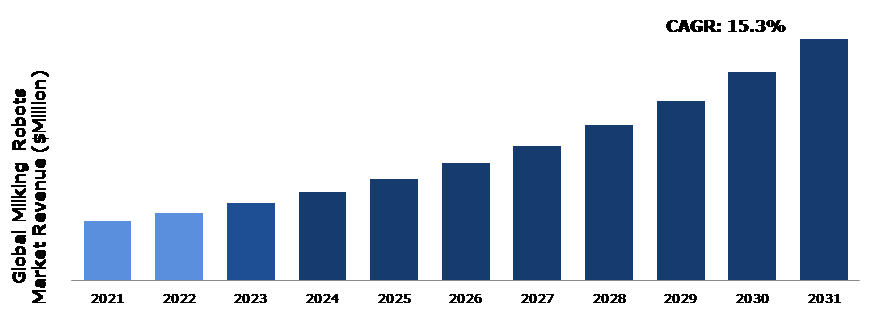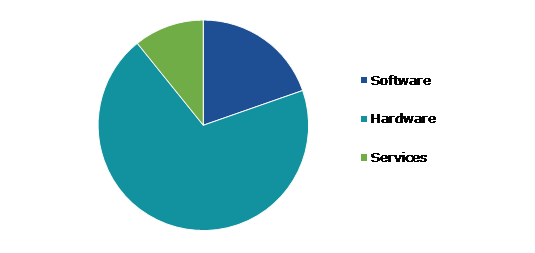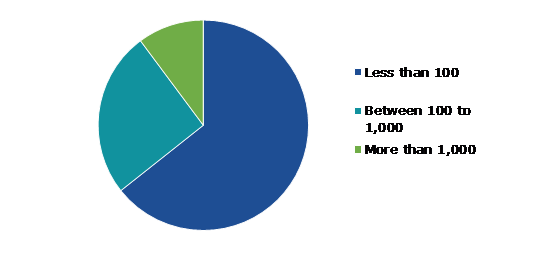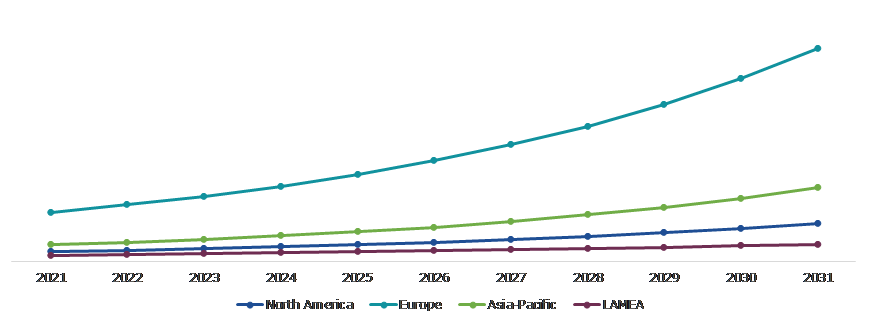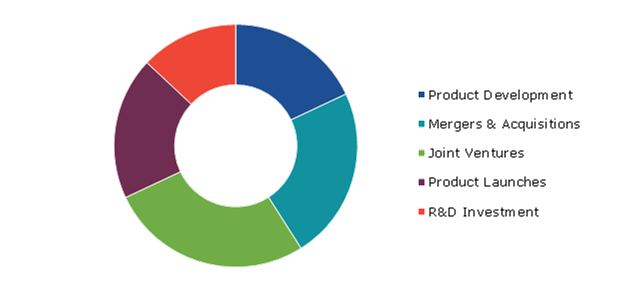Milking Robots Market Report
RA08651
Milking Robots Market by System (Single-stall Milking System, Multi-stall Milking System, and Rotary Milking System), Offering (Software, Hardware, and Services), Herd Size (Less than 100, Between 100 to 1,000, and More than 1,000), and Regional Analysis (North America, Europe, Asia-Pacific, and LAMEA): Global Opportunity Analysis and Industry Forecast, 2022–2031
Global Milking Robots Market Analysis
The Global Milking Robots Market Size was $1,692.2 million in 2021 and is predicted to grow with a CAGR of 15.3%, by generating a revenue of $6,952.9 million by 2031.
Global Milking Robots Market Synopsis
The demand for milking robots is expected to increase significantly during the forecast period on account of numerous factors including a shortage of skilled labor and a growing need for dairy across the world. Robotic milking decreases labor needs on dairy farms of various herd sizes. In the last several years, the popularity of robotic milking has increased remarkably across the world, especially in north-western Europe to reduce the need for labor on dairy farms and improve milk production per cow. Milking robots can aid farmers in achieving cost reduction while ensuring the quality of the milk and the operating environment for dairy cows. In the year 1992, the first milking robot was used on a dairy farm in the Netherlands. The number of farms worldwide with milking robots is anticipated to increase in the upcoming years mainly on account of the rising cost of labor.
However, advanced technologies such as milking robots are expensive and may not be effective for all types of farms. In addition, farmers often hesitate to adopt new farming solutions due to performance uncertainties. These factors are expected to hinder the milking robot market growth during the forecast period.
The growing use of robots in the agriculture sector is anticipated to offer ample opportunities to milking robot market players during the forecast period. Due to the shortage of workers brought on by urban migration, labor-intensive workload, and the growing rate of the world population, the adoption of robots in farm operations is increasing at a rapid pace across the world. Agricultural robots such as milking robots can outperform human intervention in terms of time management, physical labor, constant work rates under a variety of difficult environmental conditions, and final product precision.
According to regional analysis, the Europe milking robots market accounted for the highest market share in 2021 owing to presence of major players in this region, need for improving working conditions, increasing animal welfare as well as increasing milk production. Milking robots are installed majorly in the northwestern part of Europe. Countries such as the Netherlands, Sweden, Denmark, Ireland, Poland, and Germany are the key markets for milking robot players in the Europe region.
Milking Robots Overview
Milking robots also known as (autonomous milking systems) enable a complete autonomous milking operation. These robots also monitor milk quality and quantity as well as cows’ health. Farmers can select their preferred milking timing and process using this advanced robotic system. In addition, milking robots can decrease the burden of labor and improve management efficiency. Various studies have shown that the installation of milking robots results in higher milk production than the traditional milking process.
COVID-19 Impact on Milking Robots Market
The impact of the COVID-19 outbreak has rippled through several sectors causing economic as well as social disruptions across the world. It also led to disruption in the supply chain of major industries. Many companies halted or slowed down their operations during this period due shortage of labor and supply chain issues. However, the shortage of labor significantly augmented the demand for milking robots, especially in Europe and North America region. Many dairy farmers automated their milking operations to tackle the challenges presented by the pandemic. The dairy farmers who used the milking robots during the outbreak period could continue their operations without any disturbances. The resurgence of the new variant of the coronavirus is expected to increase the demand for milking robots as they can be employed to manage labor shortages and social distancing issues while improving milk production and increasing economic outcomes.
Shortage of Skilled Milking Labor to Drive the Milking Robots Market
The dairy industry's primary issue remains a labor shortage. As the agricultural workforce ages as well as become less affordable, or if stricter immigration policies are enacted globally, the supply of labor may decline in the future. In addition, concerns such as rising labor costs are also hampering the operation of the dairy. Owing to these factors, the adoption of milking robots has increased significantly in developing countries. Robotic milking increases milk production while reducing labor requirements on dairy farms of all sizes, providing a more flexible lifestyle to dairy farmers. In addition, farmers can free up manpower previously used for milking chores. As a result, farmers might need to hire less labor, saving money that might be used to pay off robot loans.
High Initial Investment along with Less Awareness in the Developing Countries to Hamper the Market Growth
The major factor that may hamper the milking robots market growth is a requirement of a large initial investment. The cost of milking robots is generally two to three times higher than a conventional milking parlor. In addition, the need for more feed to support the increased milk production drives up the cost of feed. Bacteria counts in milk can be higher because of a higher chance for microorganisms to penetrate and multiply during the milking operation. Due to their high cost and lack of awareness, the installation of milking robots is currently less common in Asia-Pacific, Latin America, and the Middle East than it is in Europe and North America.
Growing Need for Dairy Products Across the Globe to offer Excellent Opportunities
The increasing demand for milk and dairy products across the globe is anticipated to offer ample opportunities to the milking robots’ market during the forecast period. The dairy industry is growing at a rapid pace across the globe owing to the increased consumption of milk by households and the rising demand for processed dairy products such as butter, milk powders, whey, and cheese. In addition, economic recoveries post-COVID-19 pandemic and the resumption of food services are further augmenting the demand for dairy products. This, in turn, is expected to offer excellent opportunities to milking robot market players.
Global Milking Robots Market, by System
Based on system, the market is further divided into single-stall milking system, multi-stall milking system, and rotary milking system. Among this, multi-stall milking system sub-segment accounted for the largest market share in 2021 and rotary milking system sub-segment is expected to show the fastest growth rate during the forecast period.
Global Milking Robots Market Forecast, by System, 2021
The multi-stall milking system sub-segment held the largest market share in 2021. The multi-stall automatic milking system can serve up to three or four milking stalls. In this system, there is an additional device for cleaning udders. The herd size with a single-stall milking system is about 60 cows whereas with a multi-stall milking system herd size is more the 100 cows. The multi-stall milking system delivers a greater net return compared to other systems such as single-stall systems, and this net return is equivalent to conventional milking techniques.
The rotary milking system sub-segment is expected to show the fastest growth rate during the forecast period. Rotary milking systems are generally employed for a large herd size. The growing need for milk and dairy products across the globe is expected to drive the rotary milking systems during the forecast period. This system helps to bring the cows to the operator at a steady rate. This, in turn, allows a constant and efficient workflow of the dairy farm.
Global Milking Robots Market, by Offering
Based on offering, the global milking robots’ market has been divided into software, hardware, and services. Among these, the hardware sub-segment showed the highest revenue in 2021 and is anticipated to show a fastest CAGR during the forecast period.
Global Milking Robots Market Growth, by Offering, 2021
The hardware sub-segment accounted for the highest market share in 2021 and is expected to have the fastest growth during the forecast period. Growing demand for automatic milking systems across the globe as well as advancements in the milking robots by key players to launch innovative products is expected to drive hardware sub-segment growth during the forecast period. The basic components of milking robots are a vacuum pump, reserve tank, vacuum regulator, pulsator, sensors, etc.
Global Milking Robots Market, by Herd Size
Based on herd size, the global milking robots’ market has been divided into less than 100, between 100 to 1,000, and more than 1,000. Among these, the less than 100 sub-segment generated the highest market share in 2021 and the between 100 to 1,000 sub-segment is anticipated to show a fastest CAGR during the forecast period.
Global Milking Robots Market Size, by Herd Size, 2021
The less than 100 sub-segment accounted for a highest market share in 2021. The average number of cows per dairy farm is less than 100 in several of the world's major milk-producing countries and regions, including developing countries like the European Union, India, Brazil, and China, among others. Additionally, the growing concern for dairy management and farm management, the number of herds has increased. Furthermore, the designed system has proven to be an efficient way to perform milking on dairy farms, positively impacting the market.
The between 100 to 1,000 sub-segment is expected to have the fastest growth during the forecast period. Managing a dairy farm with a herd size of more than 100 cows is a challenging task for dairy farmers due to the shortage of multi-skilled labor. Due to this factor, dairy farms with a herd size of between 100 to 1000 cows are expected to increase the adoption of milking robots in the upcoming years. A moderate decline in the price of robots can make small robotic farms more competitive with bigger dairies.
Global Milking Robots Market, Regional Insights
The Milking Robots market was investigated across North America, Europe, Asia-Pacific, and LAMEA.
Global Milking Robots Market Size & Forecast, by Region, 2021-2031 (USD Million)
Europe Dominated the Milking Robots Market in 2021
The Europe region dominated the global milking robots market in 2021 on account of the presence of key players such as Lely, DeLaval, and GEA Group Aktiengesellschaft, increasing demand for milk and dairy products such as cheese and butter, increased automation in the agriculture sector, shortage of labor, increasing consumer awareness about the welfare of animals, and farm consolidation. In 2022, GEA Group Aktiengesellschaft, one of the major companies in the milking robots market, installed its largest automated milking system in Germany.
Global Milking Robots Market Competitive Scenario
Joint ventures, investment, merger & acquisition, product development, and technological development are the common strategies followed by major milking robots market players. For instance, in 2018, Lely, one of the major companies in the milking robots market launched new milking robot machine, Astronaut A5. This robot works on automatic milking principles and is easy to use.
Some of the leading players in milking robots market are Lely, DeLaval, GEA Group Aktiengesellschaft, Hokofarm Group, Fullwood Packo, Milkomax Solutions laitières, BouMatic, AktivPuls GmbH, Waikato Milking Systems NZ LP., and DAIRYMASTER.
| Aspect | Particulars |
| Historical Market Estimations | 2020 |
| Base Year for Market Estimation | 2021 |
| Forecast timeline for Market Projection | 2022-2031 |
| Geographical Scope | North America, Europe, Asia-Pacific, and LAMEA |
| Segmentation by System |
|
| Segmentation by Offering |
|
| Segmentation by Herd Size |
|
| Key Companies Profiled |
|
Q1. What is the size of the milking robots market?
A. The global milking robots market size was over $1,692.2 million in 2021 and is anticipated to reach $6,952.9 million by 2031.
Q2. Which are the leading companies in the milking robots market?
A. Lely, DeLaval, GEA Group Aktiengesellschaft are some of the key players in the global milking robots market.
Q3. Which region possesses greater investment opportunities in the coming future?
A. Asia-Pacific possesses great investment opportunities for investors to witness the most promising market growth in the coming years.
Q4. What is the growth rate of the Asia-Pacific market?
A. The Asia-Pacific milking robots market is anticipated to grow at 16.1% CAGR during the forecast period.
Q5. What are the strategies opted by the leading players in this market?
A. Product innovations, business expansions, and technological advancements are the key strategies opted by the operating companies in this market.
Q6. Which companies are investing more on R&D practices?
A. DAIRYMASTER, Fullwood Packo, and BouMatic are investing more on R&D activities for developing new products and technologies.
1.Research Methodology
1.1.Desk Research
1.2.Real time insights and validation
1.3.Forecast model
1.4.Assumptions and forecast parameters
1.5.Market size estimation
1.5.1.Top-down approach
1.5.2.Bottom-up approach
2.Report Scope
2.1.Market definition
2.2.Key objectives of the study
2.3.Report overview
2.4.Market segmentation
2.5.Overview of the impact of COVID-19 on Global milking robots market
3.Executive Summary
4.Market Overview
4.1.Introduction
4.2.Growth impact forces
4.2.1.Drivers
4.2.2.Restraints
4.2.3.Opportunities
4.3.Market value chain analysis
4.3.1.List of raw material suppliers
4.3.2.List of manufacturers
4.3.3.List of distributors
4.4.Innovation & sustainability matrices
4.4.1.Technology matrix
4.4.2.Regulatory matrix
4.5.Porter’s five forces analysis
4.5.1.Bargaining power of suppliers
4.5.2.Bargaining power of consumers
4.5.3.Threat of substitutes
4.5.4.Threat of new entrants
4.5.5.Competitive rivalry intensity
4.6.PESTLE analysis
4.6.1.Political
4.6.2.Economical
4.6.3.Social
4.6.4.Technological
4.6.5.Environmental
4.7.Impact of COVID-19 on milking robots market
4.7.1.Pre-covid market scenario
4.7.2.Post-covid market scenario
5.Milking Robots Market Analysis, by System
5.1.Overview
5.2.Single-Stall Milking System
5.2.1.Definition, key trends, growth factors, and opportunities
5.2.2.Market size analysis, by region
5.2.3.Market share analysis, by country
5.3.Multi-stall Milking System
5.3.1.Definition, key trends, growth factors, and opportunities
5.3.2.Market size analysis, by region
5.3.3.Market share analysis, by country
5.4.Rotary Milking System
5.4.1.Definition, key trends, growth factors, and opportunities
5.4.2.Market size analysis, by region
5.4.3.Market share analysis, by country
5.5.Research Dive Exclusive Insights
5.5.1.Market attractiveness
5.5.2.Competition heatmap
6.Milking Robots Market Analysis, by Offering
6.1.Software
6.1.1.Definition, key trends, growth factors, and opportunities
6.1.2.Market size analysis, by region
6.1.3.Market share analysis, by country
6.2.Hardware
6.2.1.Definition, key trends, growth factors, and opportunities
6.2.2.Market size analysis, by region
6.2.3.Market share analysis, by country
6.3.Services
6.3.1.Definition, key trends, growth factors, and opportunities
6.3.2.Market size analysis, by region
6.3.3.Market share analysis, by country
6.4.Research Dive Exclusive Insights
6.4.1.Market attractiveness
6.4.2.Competition heatmap
7.Milking Robots Market Analysis, by Herd Size
7.1.Less than 100
7.1.1.Definition, key trends, growth factors, and opportunities
7.1.2.Market size analysis, by region
7.1.3.Market share analysis, by country
7.2.Between 100 to 1,000
7.2.1.Definition, key trends, growth factors, and opportunities
7.2.2.Market size analysis, by region
7.2.3.Market share analysis, by country
7.3.More than 1,000
7.3.1.Definition, key trends, growth factors, and opportunities
7.3.2.Market size analysis, by region
7.3.3.Market share analysis, by country
7.4.Research Dive Exclusive Insights
7.4.1.Market attractiveness
7.4.2.Competition heatmap
8.Milking Robots Market, by Region
8.1.North America
8.1.1.U.S.
8.1.1.1.Market size analysis, by System
8.1.1.2.Market size analysis, by Offering
8.1.1.3.Market size analysis, by Herd Size
8.1.2.Canada
8.1.2.1.Market size analysis, by System
8.1.2.2.Market size analysis, by Offering
8.1.2.3.Market size analysis, by Herd Size
8.1.3.Mexico
8.1.3.1.Market size analysis, by System
8.1.3.2.Market size analysis, by Offering
8.1.3.3.Market size analysis, by Herd Size
8.1.4.Research Dive Exclusive Insights
8.1.4.1.Market attractiveness
8.1.4.2.Competition heatmap
8.2.Europe
8.2.1.Germany
8.2.1.1.Market size analysis, by System
8.2.1.2.Market size analysis, by Offering
8.2.1.3.Market size analysis, by Herd Size
8.2.2.UK
8.2.2.1.Market size analysis, by System
8.2.2.2.Market size analysis, by Offering
8.2.2.3.Market size analysis, by Herd Size
8.2.3.France
8.2.3.1.Market size analysis, by System
8.2.3.2.Market size analysis, by Offering
8.2.3.3.Market size analysis, by Herd Size
8.2.4.Netherlands
8.2.4.1.Market size analysis, by System
8.2.4.2.Market size analysis, by Offering
8.2.4.3.Market size analysis, by Herd Size
8.2.5.Italy
8.2.5.1.Market size analysis, by System
8.2.5.2.Market size analysis, by Offering
8.2.5.3.Market size analysis, by Herd Size
8.2.6.Rest of Europe
8.2.6.1.Market size analysis, by System
8.2.6.2.Market size analysis, by Offering
8.2.6.3.Market size analysis, by Herd Size
8.2.7.Research Dive Exclusive Insights
8.2.7.1.Market attractiveness
8.2.7.2.Competition heatmap
8.3.Asia Pacific
8.3.1.China
8.3.1.1.Market size analysis, by System
8.3.1.2.Market size analysis, by Offering
8.3.1.3.Market size analysis, by Herd Size
8.3.2.Japan
8.3.2.1.Market size analysis, by System
8.3.2.2.Market size analysis, by Offering
8.3.2.3.Market size analysis, by Herd Size
8.3.3.India
8.3.3.1.Market size analysis, by System
8.3.3.2.Market size analysis, by Offering
8.3.3.3.Market size analysis, by Herd Size
8.3.4.Australia
8.3.4.1.Market size analysis, by System
8.3.4.2.Market size analysis, by Offering
8.3.4.3.Market size analysis, by Herd Size
8.3.5.South Korea
8.3.5.1.Market size analysis, by System
8.3.5.2.Market size analysis, by Offering
8.3.5.3.Market size analysis, by Herd Size
8.3.6.Rest of Asia Pacific
8.3.6.1.Market size analysis, by System
8.3.6.2.Market size analysis, by Offering
8.3.6.3.Market size analysis, by Herd Size
8.3.7.Research Dive Exclusive Insights
8.3.7.1.Market attractiveness
8.3.7.2.Competition heatmap
8.4.LAMEA
8.4.1.Brazil
8.4.1.1.Market size analysis, by System
8.4.1.2.Market size analysis, by Offering
8.4.1.3.Market size analysis, by Herd Size
8.4.2.Saudi Arabia
8.4.2.1.Market size analysis, by System
8.4.2.2.Market size analysis, by Offering
8.4.2.3.Market size analysis, by Herd Size
8.4.3.UAE
8.4.3.1.Market size analysis, by System
8.4.3.2.Market size analysis, by Offering
8.4.3.3.Market size analysis, by Herd Size
8.4.4.South Africa
8.4.4.1.Market size analysis, by System
8.4.4.2.Market size analysis, by Offering
8.4.4.3.Market size analysis, by Herd Size
8.4.5.Rest of LAMEA
8.4.5.1.Market size analysis, by System
8.4.5.2.Market size analysis, by Offering
8.4.5.3.Market size analysis, by Herd Size
8.4.6.Research Dive Exclusive Insights
8.4.6.1.Market attractiveness
8.4.6.2.Competition heatmap
9.Competitive Landscape
9.1.Top winning strategies, 2021
9.1.1.By strategy
9.1.2.By year
9.2.Strategic overview
9.3.Market share analysis, 2021
10.Company Profiles
10.1.Lely
10.1.1.Overview
10.1.2.Business segments
10.1.3.Product portfolio
10.1.4.Financial performance
10.1.5.Recent developments
10.1.6.SWOT analysis
10.2.DeLaval
10.2.1.Overview
10.2.2.Business segments
10.2.3.Product portfolio
10.2.4.Financial performance
10.2.5.Recent developments
10.2.6.SWOT analysis
10.3.GEA Group Aktiengesellschaft
10.3.1.Overview
10.3.2.Business segments
10.3.3.Product portfolio
10.3.4.Financial performance
10.3.5.Recent developments
10.3.6.SWOT analysis
10.4.Hokofarm Group
10.4.1.Overview
10.4.2.Business segments
10.4.3.Product portfolio
10.4.4.Financial performance
10.4.5.Recent developments
10.4.6.SWOT analysis
10.5.Fullwood Packo
10.5.1.Overview
10.5.2.Business segments
10.5.3.Product portfolio
10.5.4.Financial performance
10.5.5.Recent developments
10.5.6.SWOT analysis
10.6.Milkomax Solutions laitières
10.6.1.Overview
10.6.2.Business segments
10.6.3.Product portfolio
10.6.4.Financial performance
10.6.5.Recent developments
10.6.6.SWOT analysis
10.7.BouMatic
10.7.1.Overview
10.7.2.Business segments
10.7.3.Product portfolio
10.7.4.Financial performance
10.7.5.Recent developments
10.7.6.SWOT analysis
10.8.AktivPuls GmbH
10.8.1.Overview
10.8.2.Business segments
10.8.3.Product portfolio
10.8.4.Financial performance
10.8.5.Recent developments
10.8.6.SWOT analysis
10.9.Waikato Milking Systems NZ LP.
10.9.1.Overview
10.9.2.Business segments
10.9.3.Product portfolio
10.9.4.Financial performance
10.9.5.Recent developments
10.9.6.SWOT analysis
10.10.DAIRYMASTER
10.10.1.Overview
10.10.2.Business segments
10.10.3.Product portfolio
10.10.4.Financial performance
10.10.5.Recent developments
10.10.6.SWOT analysis
Milk is a crucial component of the human diet and is consumed by a large number of households worldwide. Milk and dairy products have seen an increase in popularity in recent years. At the same time, there have been labor shortages in a variety of industries, including agricultural and dairy production. To address this issue, some farms have adopted automation technologies, which can help reduce the demand for human labor. This is where the milking robots come in.
The milking robots market refers to a sector of the dairy business that focuses on the production and marketing of automated milking systems. These robots also keep track of milk quantity and quality, as well as the health of the cows. Farmers can use this innovative robotic technology to choose their desired milking time and technique. In addition, milking robots can reduce labor requirements and boost management efficiency. Numerous studies have demonstrated that the use of milking robots increases milk output relative to manual milking.
Recent Trends in the Milking Robots Market
The milking robots market is continuously evolving with new technologies and practices. Manufacturers of milking robots are increasingly focused on animal welfare, developing solutions that are easier and less stressful for cows. For instance, some modern milking robots have soft-bristled brushes that clean and massage the cow's udder before milking, which can lessen stress and increase milk output. In addition, milking robots are rapidly being integrated with farm management software, allowing dairy producers to monitor the milking process as well as cow health in real-time. This integration helps farmers measure milk production, analyze data, and make informed herd management decisions.
Newest Insights in the Milking Robots Market
As per a report by Research Dive, the global milking robots market is expected to grow at a CAGR of 15.3% and generate revenue of $6,952.9 million by 2031. The primary factors driving the growth of the market are rising global demand for milk and dairy products such as milk whey, powders, butter, and cheese, increasing household milk consumption, and the growing number of farms globally equipped with milking robots. However, inadequate education and high initial investment in underdeveloped nations are expected to hinder the market growth.
The milking robots market in Europe is expected to remain dominant in the coming years. The region's high revenue in 2021 was driven by an increasing need for milk and dairy products such as butter and cheese, a shortage of labor, rising automation in the agriculture industry, growing public concern about animal welfare, and farm consolidation. This has led to an increased demand for milking robots to reduce the environmental impact of dairy farming by optimizing milk production and minimizing waste.
How are Market Players Responding to the Rising Demand for Milking Robots?
Market players are responding to the rising demand for milking robots by investing in research and development to create more advanced and efficient milking robots. They are also focusing on ways to improve the general design of milking robots in order to make them easier to maintain and more user-friendly.
In addition, market players are increasingly focusing on strategic partnerships and collaborations with other players in the industry to leverage their strengths and expand their reach. Some of the foremost players in the milking robots market are DeLaval, Lely, GEA Group Aktiengesellschaft, Fullwood Packo, Hokofarm Group, Milkomax Solutions laitières, AktivPuls GmbH, BouMatic, DAIRYMASTER, Waikato Milking Systems NZ LP, and others. These players are focused on implementing strategies such as mergers and acquisitions, novel developments, collaborations, and partnerships to reach a leading position in the global market.
For instance:
- In June 2021, GEA, one of the largest systems providers for the food industry worldwide, announced a new generation of the DairyRobot R9500 and DairyProQ automatic milking systems, which include major improvements to the milking technology module, the In-Liner Everything milking process, and the MilkRack milking unit, among other features.
- In January 2022, Milkomax, a worldwide producer of milking machines for tie-stall farms, launched the ROBOMAX, a milking robot of the second generation.
- In March 2022, SAC, an international supplier of milking systems, announced Gemini, a revolutionary SAC-powered milking robot. This latest generation SAC milking robot has been designed to make the dairy farmer's everyday task as efficient and joyful as possible. Gemini powered by SAC completely supports SAC's high vision to cooperate with the next generation of cows and dairy farmers by focusing on the cow, milk, and milker.
COVID-19 Impact on the Global Milking Robots Market
The COVID-19 pandemic made a positive impact on the global milking robots market. The pandemic created an urgent need for milking robots. During the pandemic, demand for milking robots increased substantially as a result of the labor shortage, particularly in Europe and North America. Many dairy farmers modernized their milking operations in response to the pandemic's challenges. The dairy farmers who employed milking robots during the outbreak period were able to carry on with business as usual. The emergence of the novel coronavirus impact is anticipated to boost demand for milking robots since they can be used to address concerns with shortages of labor and social isolation while enhancing milk output and boosting economic consequences. These factors are projected to fuel the milking robots market growth amidst the pandemic.
Personalize this research
- Triangulate with your own data
- Request your format and definition
- Get a deeper dive on a specific application, geography, customer or competitor
- + 1-888-961-4454 Toll - Free
- support@researchdive.com

